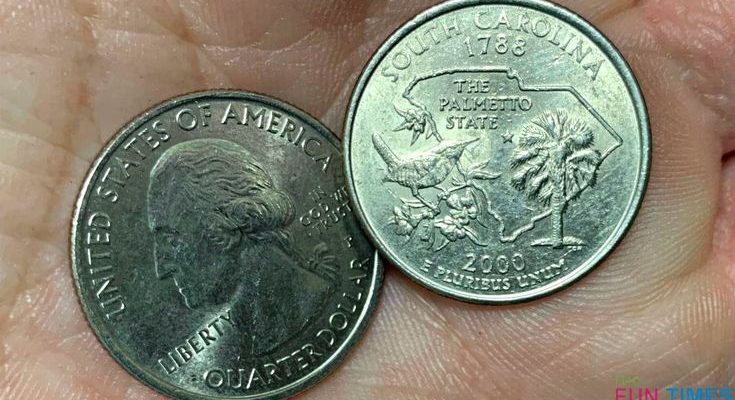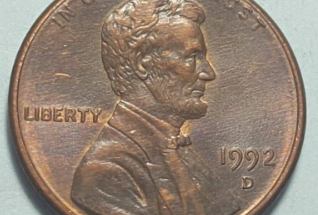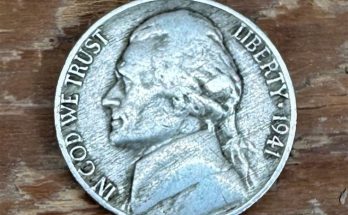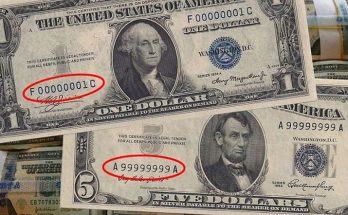If you’re looking for a 2000 South Carolina quarter error coin, you may be in luck…
There are many different types of errors to be found on South Carolina quarters!

And… they can be found in your pocket change (with enough searching and a little luck).
What types of South Carolina quarter errors should you be looking for? And how much are South Carolina error quarters worth?
Here’s the info you’re looking for…
How Much Are South Carolina Quarter Errors Worth?
State quarters with significant errors are really pretty rare. But there is still a surprising number of them floating around out there. Only a handful are considered “major errors” — yet there are many worthwhile finds.
Here are 5 types of 2000 South Carolina quarter error coins and what they’re worth today:
- Off Center South Carolina Error Quarter
One of the most common types of coin errors is the off-center strike. This happens when the die that is striking the coin and the planchet aren’t properly aligned. The percentage by which the strike is off center can range anywhere from 1% to 99%.
The most valuable examples of these off-center errors are those ranging from 10% to 60% off-center. Off-center errors showing the complete date are the most desirable among collectors. And, of course, a fully visible date is useful in determining when the coin was made.
However, in the case of the South Carolina quarter — a coin that was produced for only about 10 weeks in 2000 — we know exactly when the coin was struck even if the date is obliterated due to the off-center strike.
Off-center South Carolina quarter errors are worth anywhere from $15 to $100.
- Doubled Die South Carolina Quarter Error
A South Carolina double die (or, more properly, doubled die) is an awesome error in every respect. Doubled dies exhibit doubling in some part of the design. It is caused by doubling of the design on the die itself.
NOTE: It’s important to remember that a doubled die is not caused by the coin being struck twice.
Collectors have not yet discovered any incredibly prominent doubled dies on South Carolina quarters. But you may find evidence of doubled dies on South Carolina quarters if you look closely at the design elements, such as the:
- South Carolina state outline
- Carolina wren or the branch it stands on
- Palm
- Little star on the state
- Inscriptions
TIP: Don’t forget to check the bust of George Washington and the inscriptions around him, too!
Remember, for a South Carolina doubled die quarter to be really valuable, the doubling must be:
- Evident preferably with the naked eye OR…
- Readily visible under 5X magnification AND…
- Relatively scarce, so it commands a strong demand.
A very minor doubled die that is difficult to see with the naked eye or magnification isn’t likely to excite many in the numismatic community.
Also, a doubled die must have some demand for it to be particularly valuable. So, while many doubled dies are rare errors, if there aren’t enough people who want to collect a particular kind, it won’t necessarily be very valuable.
Doubled dies found on South Carolina quarters are generally minor and aren’t generating much attention among collectors.
Any known South Carolina double die errors are generally worth between $10 and $25.
- Clipped Planchet South Carolina Error Quarter
Sometimes coin errors happen when cutting out the round coin blanks from the large sheets of metal from which they originate. This can result in a variety of clipped edge errors.
Clipped planchet errors (also known simply as clips) may show crescent-shaped or flat cuts on the edge of a coin.
These clipped edges can be of various sizes and shapes. On rare occasions, you may even see 2 clips on a single coin!
South Carolina quarters with clipped edge errors are worth $10 and up.
- South Carolina Quarters With Missing Letters (Or Other Missing Design Elements)
Ever see a coin that is missing part of its lettering in the inscription?
These coin oddities are known as strike-through errors. Some show just part of a single letter missing, while on others larger parts of an inscription or other design element are totally obliterated. This normally happens when grease or another foreign material gets into the lettering or other crevices on the die.
One of the most popular types of state quarter strike-through errors is found on the 2005-P Kansas quarter. The so-called IN GOD WE RUST Kansas quarter is the stuff of modern error coin lore! It’s a major error on a popular coin… one that many collectors know about.
No such major strike-through errors have been reported on the South Carolina quarter yet. But that doesn’t mean they don’t exist.
Strike-through state quarter errors range in value from $5 to $10 for an obscure variety to more than $200 for rarer, popular pieces (like the 2005-P IN GOD WE RUST Kansas quarter).
- Die Cracks On South Carolina Quarters
When coin dies age or become overused, they start showing signs of wear and tear. One of the most common ways in which a die will exhibit damage is in the formation of minor cracks on parts of its surface.
These tiny cracks show up as raised lines or zig-zags on the finished coin. They can range in size from tiny pinpoint blobs to full-blown shatter lines spanning much of the surface on (usually just) one side of the coin.
A popular state quarter die crack error is the 1999 Spitting Horse Delaware quarter, showing a long, raised line originating from the horse’s mouth down toward the rim. These once sold for as much as $500 — but the prices have come down significantly since the error quarter was first discovered many years ago.
While such dramatic die cracks have not been discovered on the South Carolina quarter yet, you may be the first to find one!
Major die crack errors can be worth a pretty penny, as described above. Less-dramatic die crack errors on South Carolina quarters are worth around $10 to $25.
What If My South Carolina Quarter Has No Errors?
So it turns out that you have just a regular South Carolina 50 States Quarter with no errors?
While neat coins, these are worth face value (or 25 cents) if worn. That’s because these are very common coins, and they don’t contain any silver or other precious metals worth more than the face value of the coin.
More than 1.3 billion 2000 South Carolina quarters were made, including:
- 2000-P – 742,576,000 at the Philadelphia Mint
- 2000-D – 566,208,000 at the Denver Mint
- 2000-S – 4,985,593 at the San Francisco Mint
For a non-error 2000 South Carolina quarter to be worth more than face value, it must be either an uncirculated or proof version of the coin.
Here are values for the various uncirculated and proof 2000 South Carolina quarters:
- 2000-D and 2000-P South Carolina quarters, uncirculated – 50 cents and up
- 2000-S copper-nickel clad South Carolina quarter, proof – $1 and up
- 2000-S 90% silver South Carolina quarter, proof – $5 and up
*An uncirculated coin must not show any signs of wear.



